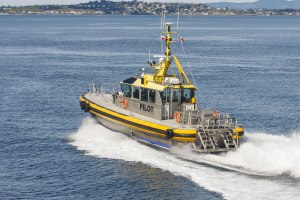
The little pilot boat bounces and slaps the waves as it sidles next to the towering cargo vessel as the two craft match speed and course, the small boat looking hopelessly fragile next to its eight-story, windowless counterpart — an egg challenging China’s Great Wall.
The cargo vessel Wisdom Ace looks more like a floating building than a ship, which makes sense: It is, in effect, a sea-going parking garage, a very specialized sort of cargo ship known as a RO-RO (for “roll-on, roll-off)”. It’s a car carrier, and the beauty of this type of vessel is that the cargo can be driven on and off rather than craned into place like containers. Today the Wisdom Ace carries 5,000 Mercedes cars and SUVs from Germany, parked and lashed bumper to bumper on the ship’s many decks. The Jacobsen Pilot Service boat is there to deliver a pilot, whose job is to bring the big ship and its costly cargo safely in to dock at the Port of Long Beach, California.
The Jacobsen boat steers close enough to count the rivets in the big ship’s looming expanse of steel plating; close enough to lean out and touch the rivets.
A third of the way up the featureless expanse of the Wisdom Ace’s hull — which is long and wide enough to cover two football fields — a door opens out to nowhere about 20 feet above the roiling water. This is the pilot’s door. A rope ladder is dangled from it, and two men peer down, one of them waving.
“That’s my cue.” Bob Blair stands up and stretches. He had been resting in the sun-drenched stern of the pilot boat, maybe even dozing. It seems mariners can sleep through chop and wind and the approach of floating buildings, no problem. He had been up since three that morning, after all, and this would be the third ship he piloted this day through the Port of Long Beach’s narrow and quirky channels, which features a bridge so old it must wear a diaper to catch falling bricks, and submerged obstructions with such ominous nicknames as “the Can Opener.” Blair, like his fellow pilots, knows all these idiosyncrasies, dangers, twists and tight spaces as no visiting helmsman could. It’s his job to find the safest path to bring the cargo across the last few watery miles of a global crossing.
At the twin ports of Los Angeles and Long Beach, the largest in North America, this how a third of the nation’s consumer products find its way to our doorsteps. Port pilots are among the elite of the door-to-door global machine, part of its hidden choreography, essential but unheralded professionals who keep the cargo on the world’s biggest ships moving through its tightest, most congested spots.
The pilots, like the rest of the door-to-door economy they serve, are creatures of movement, always on call.
No cargo ship can dock without the pilots’ good graces so, in a sense, almost the entire consumer economy is, however briefly, is in their control. The pilots are the closers of the door-to-door world, a breed apart, with coveted jobs that pay some of the highest salaries in the marine business as they use state-of-the-art mobile navigation tech combined with a deft feel for ships, tides and wind that is as old as seafaring itself. At Long Beach the pilot salaries range from about $300,000 to nearly half a million dollars a year.
The sandy-haired Blair, with his blue dress shirt, necktie and immaculate black windbreaker, steps up to the port-side gunwale of his boat, adjusts the zipper on his jacket, and leans out over the whitecaps. Without breaking stride, he grabs the rope ladder and steps up onto its nearest rung, a single fluid, casual motion, as if he were stepping from street to curb rather than leaping onto a steel-walled monster that could kill him in an instant if he slipped. He nimbly scales the ladder and disappears though the door as the pilot boat peels off, dodging the frothing wake kicked out from the big car carrier.

Image: Shutterstock/Darryl Brooks
Less than 45 minutes later, Blair squeezes the Wisdom Ace and its payload of German vehicles through the port and into its berth at Pier F. There the stevedore gang begins unleashing the cars, driving them down the ramp and off to a holding area to await movement to the port’s rail terminal. Luxury cars and SUVs stream off the ship like spectators leaving the ballpark after a game, Ro Ro’s ingenious design allow ramps to shift up or down as each successive deck is emptied.
It is almost 11:00 a.m. by now, and Blair is already getting word on his next assignment, piloting a container ship out of China to the backlog anchorage. The pilots, like the rest of the door-to-door economy they serve, are creatures of movement, always on call.
From Door to Door by Edward Humes Copyright © 2016 by Edward Humes. Reprinted courtesy of Harper, an imprint of HarperCollins Publishers.
Featured Image: tonton/Shutterstock
